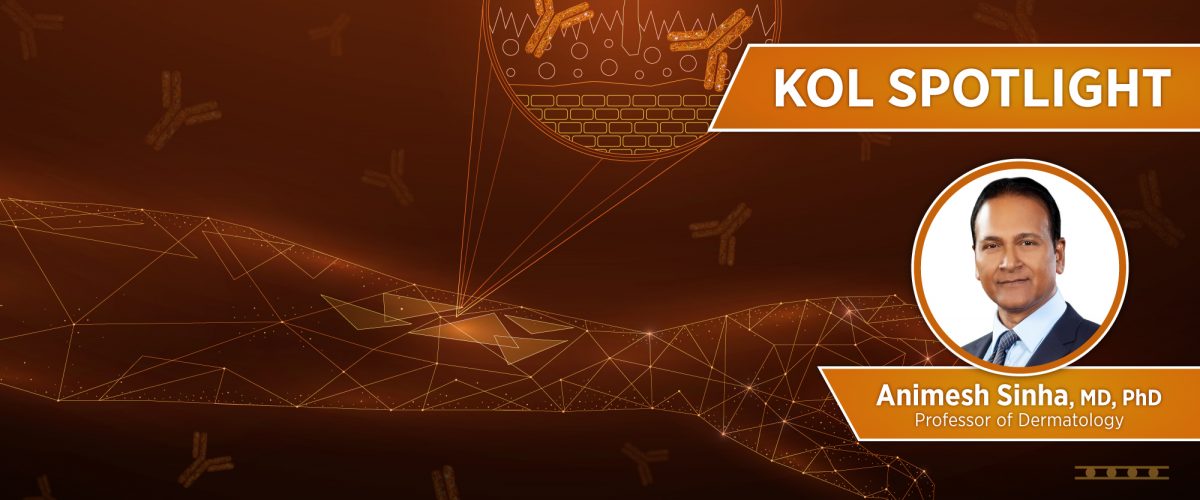KOL Spotlight Interviews is a segment where we interview experts in various fields on their expertise and insights that continue to help shape the diagnostics and pharmaceutical industries. This month, we have the pleasure of welcoming Dr. Animesh Sinha from University at Buffalo.

Animesh Sinha MD, PhD Board-certified dermatologist and professor at University at Buffalo in Buffalo, NY
Dr. Animesh Sinha completed his MD degree in 1982 and PhD degree in 1986 from University of Alberta. He also pursued post-doctoral research at Stanford University and subspecialty training in dermatology at Yale University. Dr. Sinha has published over 150 peer-reviewed articles and received numerous honors and awards for his academic activities. Below, we will learn more about his experiences and insights in autoimmune blistering skin diseases and the importance of early diagnostics.
Q: Can you walk us through a little bit about your career path? What prompted you to not only get your MD but also PhD and how has having both the clinical and research background shaped your career?
A: My career path was shaped pretty early on. My parents were both professors and I started getting involved with science fairs as early as elementary schools and reaching the national science fair level in my high school years. Ultimately, I developed an interest in medicine and learning about the human body and disease, and [eventually] entered medical school. Throughout my graduate and medical school years, I participated in research and got hooked on scientific inquiry and trying to find out how things work. After medical school, I entered a graduate program and earned my PhD in immunology. In my perspective, science and medicine are intertwined and is an ever-evolving journey that we continue to work on, in my career and in society, as a whole. Having that perspective shaped the way I look at disease, the mechanisms of disease, and how to treat patients.
Q: Autoimmune blistering diseases are a group of rare skin diseases. What interested you in specializing in this field and why is this a significant area of research?
A: My interest in autoimmunity was sparked during my first immunology lecture in my second year of medical school. The central question of the immune system is: how does the immune system distinguish self from non-self? How does our body know to react and counteract all the pathogens (viruses, bacteria, cancer cells, etc.) but not attack its own tissues? It’s one of the most fascinating biological questions that exists to this day. On the flip side, in certain conditions, we breach that self-tolerance and our immune system starts to attack our own tissues. That attack can occur in any organ system including the skin. I started to be involved with projects to understand why certain people are susceptible to disease.
These diseases are multifactorial: genetic and environmental factors. My initial work was trying to figure out the genetics and who is at risk and we studied specific key genes called human leukocyte antigen (HLA) genes that are key regulators in initiating normal and abnormal/autoimmune responses. It turned out that there’s a very strong linkage of these genes to autoimmune diseases, especially in pemphigus vulgaris (PV). I’ve sequenced the genes that were important for PV some years back and that sparked my interest in learning more about how this disease manifests in patients. It turns out that PV is an excellent model to study human autoimmunity. That set me off in a trajectory to study PV and autoimmunity has continued as a theme throughout my career.
Q: What key questions do you try to answer when determining whether a patient might have pemphigus vulgaris (PV) or mucous membrane pemphigoid (MMP)? And what are some key biomarkers that help aid in your diagnosis?
A: The keys to diagnosis of autoimmune blistering disorders such as pemphigus and pemphigoid are 1) clinical signs and symptoms, 2) histopathology: taking a biopsy and looking at where the split of the skin occurs, 3) direct immunofluorescence (DIF) in the skin where we look for immunoglobulins to show up in the skin of a lesion, 4) indirect immunofluorescence testing (IIFT) where we look for autoantibodies in the serum that are relevant in these diseases. We can also directly test for key autoantibodies linked to pemphigus or pemphigoid by doing enzyme-linked immunosorbent assay (ELISA). Finally, we sometimes do genetic testing for key immune gene regulators that help us make the diagnosis.
Q: Since both PV and MMP are autoimmune diseases in which antibodies target desmosomal proteins, what antibodies are crucial for detection and what methods are typically used for detecting the antibodies?
A: Autoimmune skin blistering diseases can be divided into 2 groups: pemphigus and pemphigoid. In the pemphigus group, the split in the skin where the blister forms is in the bottom of the epidermis (top layer of the skin). In the pemphigoid group, the split is just below the epidermis (it’s subepidermal). That creates a more fragile type of blister in the pemphigus group and more tense in the pemphigoid group. These related but distinct clinical conditions are linked with slightly different autoantibodies. In PV, the primary autoantibodies are directed against 2 key proteins that help hold the skin together. These proteins are desmoglein-3 (DSG-3) and desmoglein-1 (DSG-1). There have been reports of other non-desmoglein proteins that are relevant for PV, but DSG-3 and DSG-1 are the primary targets. In MMP, the primary autoantibodies are BP180 and BP230. It’s fascinating how the exquisite specificity to slightly different targets within the skin can result in distinct clinical entities.
Q: According to the International Pemphigus & Pemphigoid Foundation, it took patients 10 months on average to achieve a correct diagnosis. Why is early detection important and what are some sequalae patients should look out for that could potentially be irreversibly damaging?
A: If we think of these diseases as a runaway train, you can imagine that the longer you wait to stop this train, the more damage and destruction can occur in the body. It’s imperative that we have the tools to help recognize molecular and immune components that are contributory to disease to detect them and implement therapies that will halt this runaway train.
Q: What are some methods used to monitor disease activity? Are there similar methods for monitoring therapeutic drug activity too?
A: To monitor disease activity, we first rely on clinical features and documenting the lesions on mucosal and non-mucosal surfaces of the skin. Secondly, we can monitor the key autoantibodies that are relevant for pemphigus and pemphigoid diseases. We do this mainly by ELISA, but new tools are coming to help us track and follow the abundance of these autoantibodies in the serum of patients. Additionally, there has been work looking at cytokines (soluble immune mediators) of the immune system that may also be key in promoting disease. Finally, we are also looking across the genome to see what genes are increased or decreased in the blood or tissue to determine what factors beyond autoantibodies are relevant for disease. Together, we hope to get increasingly robust elements to look at when we’re tracking and monitoring disease and response to treatment.
Q: How is the diagnostics industry changing regarding autoimmune blistering diseases, and regarding therapies, can you highlight some key clinical trials that are ongoing?
A: In the past, we’ve had tools that look at a single marker/antibody at a time. We’re now emerging into an era with multiplexed assays where we can look at multiple autoantibodies at once via ELISA, IIFT, or protein microarrays on a glass chip. This has been a continued story to develop more useful and accurate tests for diagnosis. Regarding clinical trials, in pemphigus, recent trials have shown efficacy of Rituxan© or anti-CD20 antibody. There are now ongoing trials looking at therapy directed against FcRn [Neonatal Fc receptor]. These are molecules that are important in keeping antibodies in the circulation. So, inhibiting them could decrease autoantibodies in the serum and mitigate disease. There are also trials looking at B cell markers (i.e., BTK protein) that are being inhibited to see how that approach to therapy is effective for pemphigus.
Q: What impact do you think companion diagnostics will have in the field of autoimmune blistering diseases and do you think the future of therapeutics will utilize a more personalized approach?
A: Increasingly companion diagnostics will be very relevant to monitoring, treating, and personalizing management for autoimmune blistering disorders. At the moment, roughly only a third of patients respond to any given medication. The problem is we don’t know which subset of patients will respond very well to a given medication. As we develop companion diagnostics including ELISA and other multiplexed assays to look at key autoantibodies, key cytokines, gene expression changes, these will be used ultimately to better characterize and subset patients and define those patients that are more likely to respond to a given medication over another. Therefore, more scientifically and rationally tailor medications to certain patient subsets and individuals to lead us to a more personalized era of medicine.
Q: What do you see as possible hurdles that primary care physicians, dentists, and other HCPs face in the accurate detection of PV and MMP?
A: There are a lot of hurdles in terms of accurately diagnosing and managing PV and MMP. Firstly, these are rare diseases and many physicians and even specialists haven’t been exposed to many patients with these diseases. Secondly, the symptoms can come on over time and not declare themselves very clearly for several months. Finally, a number of diseases can present with blisters, especially lesions in the mouth, and it’s sometimes hard to pinpoint these as an autoimmune blistering disorder. As we get more accurate and usable clinical tests for diagnosis, this will increase our ability to rapidly and accurately diagnosis autoimmune blistering disorders.
Thank you, Dr. Sinha, for helping our audience, from clinicians to laboratorians to patients, gain a better understanding and perspective on autoimmune blistering skin disease and the impact accurate diagnostics continues to have.
To hear more from Dr. Sinha, click here to watch this recent webinar where he dives into detail on the questions above.
To hear from one of Dr. Sinha’s patients, check out this blog post and video about her journey to proper diagnosis.





